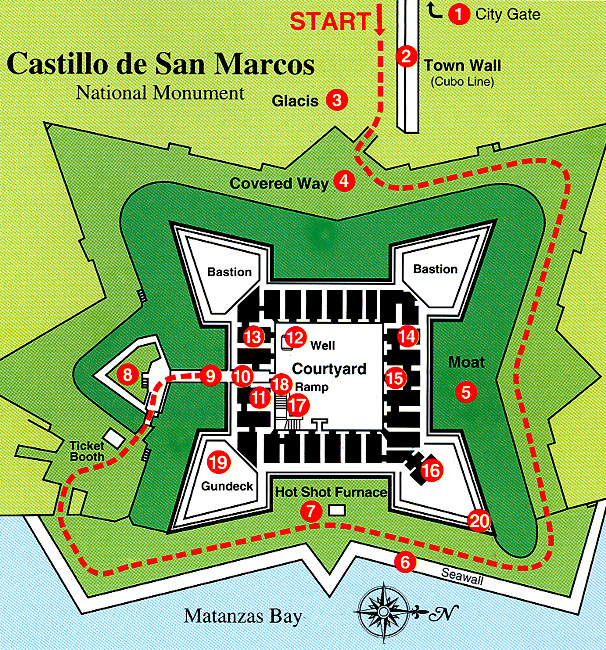Source: St. Augustine's Historic Points of Interest Including 5 Walking Tours, 2004 Historic Print and Map Co, St. Augustine, Florida.
Comments: This kind of fortification is called a "star fort." (Strictly speaking, it is not a castillo or castle.) It was created when gun powder began to be used in European warfare in the middle of the fifteenth century. The special innovation in this kind of aggressive fortification is its flatness with triangular corner bastions, which were designed to provide fire cover between them. In additiuon, a ditch or dry moat was added around the fort. For the Castillo de San Marcos, as you see, the moat was needed only on the three land sides because the fourth side was protected by Matanzas Bay. When star forts were developed, warfare shifted from open pitched battles among two or more knights and peons to siege warfare. This castillo/fort withstood two such sieges. The first took place in 1702 when British governor of Carolina attempted to capture Spanish San Agustín. This city's residents (1,200 people) entered the fort with 300 soldiers, stocked food, sheltered their livestock in the moat, and withstood a siege that lasted two months. British cannonballs did little damage to the fort because the coquina stone (native to Florida) was able to absorb the impact of the cannonballs. Finally, when Spanish ships arrived from La Habana, Cuba, the British fleet was trapped in Matanzas Bay; the British burned their ships and fled back to Carolina on land, but the British did manage to burn down much of the city outside the "Castillo." The second siege occurred in 1739, during the so-called War of Jenkins' Ear (1739-1742) between Great Britain and Spain, which Spain won). This time the famous British General James Oglethorpe (founder of the English Colony of Georgia) besieged San Agustín. Again the Spanish governor—this time, Manuel de Montiano—gathered the city within the Castillo while Oglethorpe landed on Anastasia Island. While his cannons were firing on the fort, a Spanish ship from San Agustín managed to get through the British naval blockage at the mouth of Matanzas Inlet and sailed to La Habana. When this boat returned from Cuba, the British had already abandoned the siege because the fort's coquina walls once again successfully withstood the bombardment.
Humanities themes: military arts; Renaissance fortification architecture.

